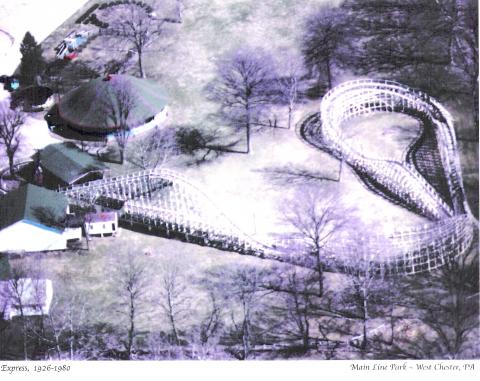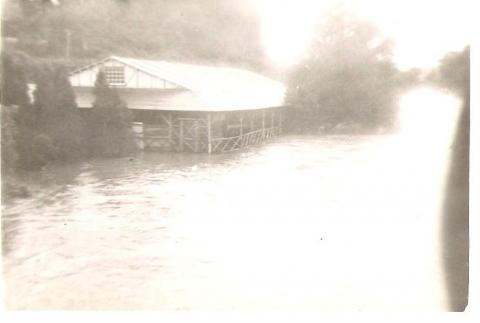Lenape Park
At the turn of the 20th Century, Pocopson was home to one of the region’s popular recreation spots—Lenape Park, on the Brandywine. Reports differ on its early history. As early as 1858, according to one source, picnics were held on the site, even though the ground was overrun with bushes and vines. The more organized site started in 1877, in the middle of a hickory grove on Sager’s Island, when a group of local residents got together with hatchets and saws and constructed an open-air dance platform.
Meanwhile, according to another source, another site was drawing people for picnicking, camping and fishing. It was a meadow along the Brandywine in Birmingham Township on Creek Road near Meetinghouse Road. In 1886, the Wilmington and Northern Railroad floated the idea of dropping off passengers nearby, with a footbridge across the Brandywine so that the crowds could reach the grounds. More picnic tables and swings were put in place, facilities were added for boating, swimming, baseball, cricket and outdoor bowling. A restaurant was built, and a merry-go-round was brought in. Suddenly, Birmingham Park was “the place to be” for summer fun, with as many as 600 to 800 patrons flowing in from surrounding communities and places as far away as Reading, Pottstown, Delaware and New Jersey.
But this success was soon to end.
Earlier, the route of the trolley service provided by the West Chester Street Railway Company was traced south from West Chester to Lenape. From there, it could have been possible to build a spur line to serve Brandywine Park. But when the trolley reached Lenape in 1891, Mr. William M. Haynes (whom we met above), then apparently the president of both the railroad and the trolley company, saw a way to increase revenue still further without this additional expense. He built a park on the triangular plot of land between the trolley station at Lenape and the Brandywine Creek, and had a footbridge erected over the creek. By the summer of 1892, trolley riders could enjoy a picnic ground, a café, a 200-foot long, 12-foot wide boardwalk flanked by 18 settees, a boating wharf, a carousel, a beach created from several trainloads of beach sand; a man-made lake, and a covered dance pavilion. These attractions moved the locals to begin to compare Lenape Park favorably to Atlantic City and Coney Island.
A dam was built to raise the level of the creek, and the steamboat “Hiawatha” offered cruises. Canoes were available, and theatrical performances were held. A roller skating rink was built, and in the winter, there was ice skating on the pond.
Sunday Schools scheduled picnics at the park; The Mountain Springs Rifles of Ephreta, Lancaster County, and the Boys’ Brigade of Philadelphia held week-long camps; 1500 men, women and children with the Iron Moulders of Reading came to the park on a special train.
Even as early as 1892, there were raves about the park. As one newspaper cheered, “Who would have thought that tame, ugly and uninviting Lenape (as it was) would bloom so as to become a rival to Atlantic City, Coney Island and other similar resorts?” In that year, the park attracted as many as 900 people in one day. By 1906, the record had grown to four to five thousand in one day, and by the middle of the 20th Century, more than 200,000 people attended in one season.
Lenape Park continued to add features to attract the public. The first merry-go-round at Lenape Park was initially powered by farm boys (replaced in turn by horses, then a gasoline engine, and then electricity). The last merry-go-round was hand-carved by Philadelphia cabinetmaker Gustav Dentzel. It contained 52 carved animals, including prancing horses, a ferocious tiger, a lion and a strutting giraffe. Music was supplied by the Wurlitzer Band organs, crashing cymbals and thumping drums.
In 1926, a “twister-coaster” was built at the park. The start of the run was 45 to 50 feet high, and there were 1400 feet of track. Five years later, a miniature golf course was built, and new and speedier bumper cars were in use.
One of the biggest annual attractions was the Old Fiddlers congregation in early August when Chris Sanderson, Chester County historian, and fiddlers from all around gathered for a day of old-fashioned country music. Sunday night concerts on the park’s outdoor stage also drew a crowd.
Lenape Park was not without its problems. At the outset, the electric supply was so limited that, when trolleys would leave to climb the hills on either side, there wasn’t enough power, and the lights would grow dim. Large crowds sometimes brought out rowdy behavior, like gambling and beer drinking. There was even one report of women actually drinking beer, mothers giving beer to their children, and young men and women drinking together freely. Some campers also became mischievous, foraging for a local farmer’s ducks.
There were charges that the park’s management discriminated against African-Americans, who were barred from certain dances and even from the park itself. The Lenape Park dance pavilion was opened on June 23, 1894, and a Daily News story reported, “The orchestra had struck up a catchy polka and the floor was occupied by a half-dozen couples when two colored youths….mingled with the dancers. Almost immediately, the floor was deserted by the white people,” and the company president, William M. Hayes asked them to leave. Five years later, the same newspaper reported that African Americans no longer went to Lenape Park. As late as the 1930’s and 1940’s, Lenape Park was open only one day a year to them – the last Thursday in August.
Local weather also presented challenges. Heavy rains would put the Brandywine into flood stage, and raging waters would deposit mud and debris on the grounds, lifting the boardwalk from its moorings and washing away its supports, damaging the band organs of the merry-go-round. Rains, and also winter’s ice gorges also damaged the breast of the Sager dam. Newspaper reports, seemingly every other year or so, would detail the breaches in the dam structure. To add insult to injury, the local muskrats were charged with burrowing in the banks of the creek until they were riddled with holes and so weakened that they could no longer hold back a body of water a quarter of a mile wide and two miles long.

Birmingham Park struggled along for a few years after Lenape Park started. But the railroad took down the footbridge over the Brandywine in 1899. A few die-hards who remembered the glory days continued to hold affairs there, but it finally closed in 1917.
Another picnic park briefly made its appearance in the area. In the 1890’s, a group started Brandywine Park in nearby East Bradford Township to offer boating, picnicking, a restaurant and a boardwalk. But it soon disappeared. The area is now known as Brandywine Picnic Park (www.picnic.com). Additional historic photos can be found at http://www.oldwilmington.net/oldwilmington/lenape-park.htm
| Attachment | Size |
|---|---|
| 85.64 KB | |
| 72.89 KB | |
| 361.92 KB |

